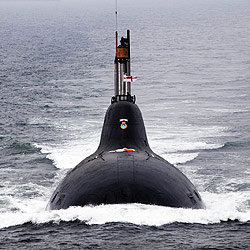
With this, the country has moved a step towards completing the nuclear troika - capability to launch nuclear weapons from land, air and sea.
According to a news channel report, all systems of the indigenously-made 83 MW pressurised light-water reactor are "go" after many rounds of checking and re-checking.
The 6,000-tonne submarine at the secretive ship-building centre at Visakhapatnam will soon be launched to sea on the Eastern coast.
India is the only nation in the Indian Ocean region to have a nuclear submarine and the sixth in the world to have the capability to design and construct a nuclear submarine
The orange beacon atop the conning tower came to life on July 26, 2009, as Prime Minister Manmohan Singh's wife Gursharan Kaur had pressed the button to symbolise the launching of the vessel into water.
In the middle of the body - comprising an outer hull through which the water goes in and an inner pressurised hull - on the starboard side are two rectangular vents, meant to take in water when the vessel dives into the sea. It is like a "cocoon within a cocoon", an official had explained.
INS Arihant is longer than any of the submarine in the Indian Navy's fleet so far. A nuclear submarine is powered by a nuclear reactor, which generates tremendous heat driving a steam turbine. It has unlimited underwater endurance and speed twice that of its conventional counterparts.
The submarine can carry 12 nuclear missiles K-15. Keeping in line with its "no first use policy", the submarine will help India in developing a "credible second strike capability" in case of nuclear attack, said officials.
Indian Navy has been operating conventional diesel-electric submarines, which have to surface to charge their batteries.








Comments
Add new comment